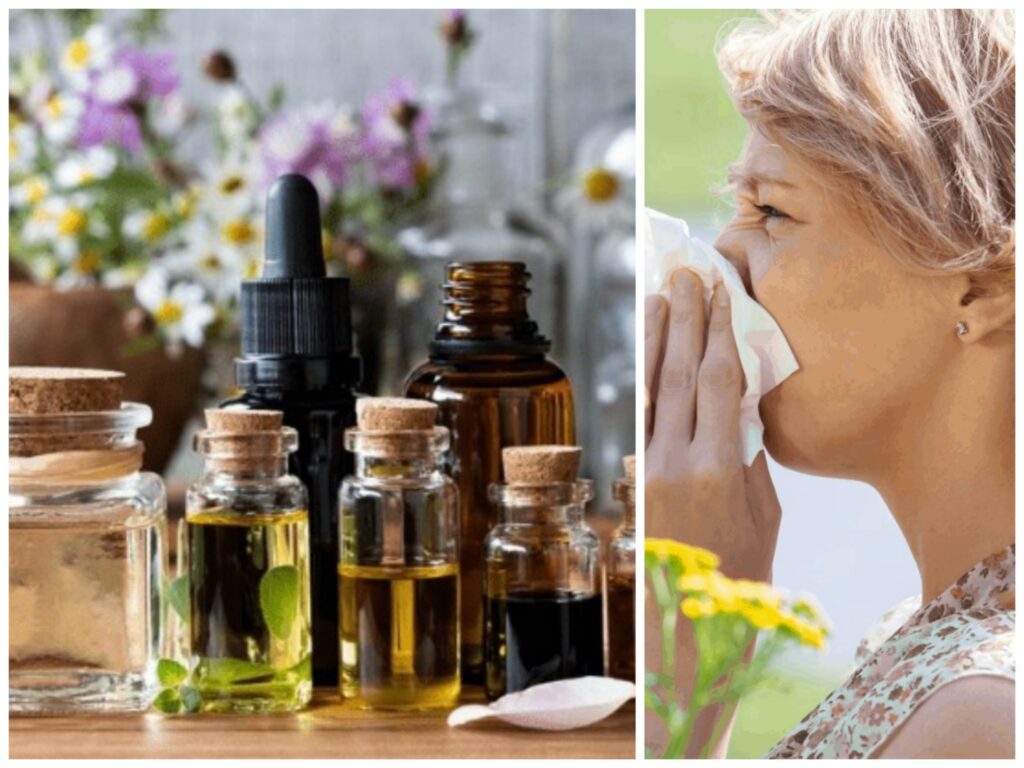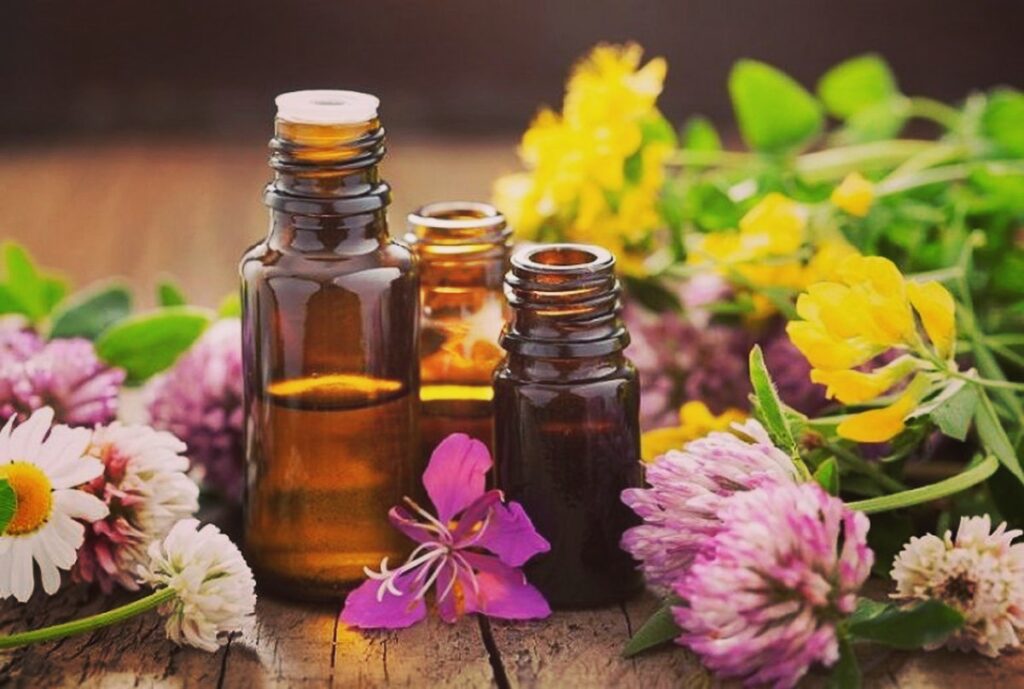Understanding Allergies: Causes, Symptoms, and Relief with Bhramara Mudra, natural remedies and essential oil
Allergies are a common condition that affects millions of people worldwide. It is an immune response to a particular substance that the body perceives as harmful, even though it is not. The immune system overreacts to the substance and produces antibodies that cause allergic reactions. This article will discuss what allergies are, their major causes, how to identify them, and the types of allergic reactions in the body.
What Are Allergies? Allergies are a condition where the immune system overreacts to a substance that is usually harmless to the body. The immune system responds by producing immunoglobulin E (IgE) antibodies, which attach themselves to cells that release histamine and other chemicals in the body. Histamine is responsible for the symptoms associated with allergies, such as sneezing, itching, and swelling.
Allergies can develop at any age, but they usually appear during childhood. Some people may outgrow their allergies, while others may continue to have them throughout their lives. Allergies can be mild or severe, and some may even be life-threatening.
What Is The Major Cause Of Allergies? There is no one major cause of allergies. Allergies can be caused by a variety of factors, including genetics, environmental factors, and lifestyle choices.
Genetics: If a person has a family history of allergies, they are more likely to develop them. The risk of developing allergies is higher if both parents have allergies. Some studies suggest that certain genes can increase the risk of developing allergies.
Environmental Factors: Environmental factors, such as pollution and exposure to allergens, can trigger allergies. Allergens are substances that cause allergic reactions, such as pollen, dust mites, pet dander, and certain foods.
Lifestyle Choices: Lifestyle choices, such as smoking and poor diet, can also increase the risk of developing allergies. Smoking can irritate the lungs and cause respiratory problems, making it more difficult for the body to fight off allergens. A diet high in processed foods and low in fruits and vegetables can weaken the immune system and increase the risk of allergies.
How Can You Identify AnAllergy? Allergies can be identified through various tests and symptoms. Some common tests for allergies include skin tests, blood tests, and elimination diets.
Skin Tests: Skin tests involve applying a small amount of allergen to the skin and then pricking or scratching the skin to see if there is a reaction. If the skin becomes red and itchy, it may indicate an allergy.
Blood Tests: Blood tests can detect the presence of specific antibodies to allergens in the blood. Blood tests are useful for people who cannot undergo skin tests, such as those with severe eczema or a skin condition that affects the skin barrier.
Elimination Diets: Elimination diets involve eliminating certain foods from the diet to see if symptoms improve. If symptoms improve after eliminating a particular food, it may indicate an allergy.
Symptoms of Allergies: Symptoms of allergies can vary depending on the type of allergy and the severity of the reaction. Some common symptoms of allergies include Sneezing, Runny or stuffy nose, Itchy, watery eyes, Skin rash or hives, Swelling of the face, lips, tongue, or throat, Wheezing or difficulty breathing, Abdominal pain, diarrhea, or vomiting.
Types of Allergies: There are several types of allergies, including:
Allergic Rhinitis: Allergic rhinitis, also known as hay fever, is a common allergy that affects the nasal passages. It is caused by exposure to allergens such as pollen, dust mites, and animal dander. Symptoms of allergic rhinitis include sneezing, runny nose, congestion, and itchy, watery eyes. Treatment for allergic rhinitis includes antihistamines, decongestants, nasal corticosteroids, and immunotherapy.
Food Allergies: Food allergies are a common type of allergy that affects both children and adults. It occurs when the immune system overreacts to certain foods, such as peanuts, tree nuts, shellfish, and eggs. Symptoms of food allergies can range from mild to severe and can include hives, itching, swelling, difficulty breathing, and anaphylaxis. Treatment for food allergies includes avoiding the allergen, carrying epinephrine, and seeking emergency medical attention if symptoms occur.
Skin Allergies: Skin allergies, also known as contact dermatitis, occur when the skin comes into contact with an allergen, such as poison ivy or nickel. Symptoms of skin allergies include redness, itching, and swelling. Treatment for skin allergies includes avoiding the allergen, using topical corticosteroids, and taking oral antihistamines.
Drug Allergies: Drug allergies occur when the immune system overreacts to a medication. Symptoms of drug allergies can range from mild to severe and can include hives, itching, swelling, and anaphylaxis. Treatment for drug allergies includes avoiding the medication, seeking emergency medical attention if symptoms occur, and wearing a medical alert bracelet.
Insect Sting Allergies: Insect sting allergies occur when the immune system overreacts to an insect sting, such as a bee or wasp sting. Symptoms of insect sting allergies can include hives, itching, swelling, and anaphylaxis. Treatment for insect sting allergies includes avoiding the insect, carrying epinephrine, and seeking emergency medical attention if symptoms occur.
Conclusion: Allergies are a common condition that affects millions of people worldwide. It occurs when the immune system overreacts to a substance that is usually harmless to the body. Allergies can be caused by a variety of factors, including genetics, environmental factors, and lifestyle choices.
Symptoms of allergies can vary depending on the type of allergy and the severity of the reaction. Treatment for allergies includes avoiding the allergen, using medications, and seeking emergency medical attention if necessary. If you suspect that you have an allergy, it is essential to seek medical advice and get the proper diagnosis and treatment.
You can alleviate allergy symptoms with Bhramara Mudra:

Bhramara Mudra is a yoga practice that can help alleviate allergies by calming the mind and body. It is a simple technique that involves placing the index finger on the base of the thumb and gently pressing the thumb over the finger. The Bhramara Mudra, also known as the Bee Gesture, is named after the bee because it resembles the bee’s wings when it is in a relaxed state. This mudra can help relieve allergies by calming the nervous system and reducing stress and anxiety.
To practice Bhramara Mudra, sit comfortably in a quiet and peaceful place. Close your eyes and take a few deep breaths. Bring your hands to your knees and gently fold your index fingers to touch the base of your thumbs. Extend your middle, ring, and little fingers straight out. Place the tip of your thumb on the side of your middle fingernail on both hands. Relax your hands and let your wrists rest on your knees.
Hold the mudra for 5-10 minutes, or as long as you like, while focusing on your breath and relaxing your mind and body. Release the mudra and take a few deep breaths before opening your eyes. Regular practice of Bhramara Mudra can help alleviate symptoms of allergies, such as sneezing, congestion, and itchy, watery eyes. It can also help reduce stress and anxiety, which can exacerbate allergy symptoms.
It is important to note that while Bhramara Mudra can be a helpful practice for alleviating allergies, it should not be used as a replacement for medical treatment. If you are experiencing severe or persistent allergy symptoms, it is important to seek medical advice and treatment.
Home remedies for allergies.
Allergies are a common condition that affects millions of people worldwide. It is caused by the body’s immune system overreacting to a substance that it perceives as harmful, but in reality, it’s not. Common allergens include pollen, dust mites, animal dander, and certain foods. Allergic reactions can range from mild to severe and may result in symptoms such as itching, sneezing, coughing, and wheezing. While there are several medical treatments available to manage allergies, many people prefer using home remedies to alleviate their symptoms. In this article, we will discuss some effective home remedies for allergies and how we can protect ourselves from allergies.
Home remedies for allergies:

Honey: Honey is a natural antihistamine and has been used for centuries to treat allergies. It contains trace amounts of pollen, which can help the body build immunity to it. Honey also has antibacterial properties that can help soothe a sore throat caused by allergies. To use honey, mix one tablespoon of honey into a cup of hot water and drink it as tea. You can also add honey to your food or eat it straight off the spoon.
Apple cider vinegar: Apple cider vinegar has anti-inflammatory properties that can help alleviate allergy symptoms. It also has a high potassium content, which can help reduce mucus production. To use apple cider vinegar, mix one tablespoon of apple cider vinegar with a glass of water and drink it twice a day. You can also add apple cider vinegar to your food or use it as a salad dressing.
Turmeric: Turmeric is a spice commonly used in Indian cuisine and has anti-inflammatory properties that can help alleviate allergy symptoms. It also contains curcumin, a compound that can help boost the immune system. To use turmeric, add it to your food or drink it as tea. To make its tea add 1 teaspoon of turmeric and 1 teaspoon of honey. You can also take turmeric supplements, but be sure to consult your doctor before doing so.
Probiotics: Probiotics are good bacteria that can help boost the immune system and improve gut health. This can help alleviate allergy symptoms by reducing inflammation in the body. Probiotics can be found in fermented foods like yogurt, kefir, and sauerkraut. You can also take probiotic supplements, but be sure to consult your doctor before doing so.
Saline solution: Saline solution can help alleviate allergy symptoms by flushing out allergens from the nasal passages. To make a saline solution, mix one teaspoon of salt with eight ounces of warm water. Use a bulb syringe or a neti pot to flush the saline solution into your nostrils. Be sure to use distilled or sterilized water to avoid introducing bacteria into your nasal passages.
Steam: Steam can help alleviate allergy symptoms by reducing congestion and opening up the nasal passages. To use steam, fill a bowl with hot water and place your face over it. Cover your head with a towel to trap the steam and inhale deeply for a few minutes. You can also take a hot shower or use a humidifier to add moisture to the air.
Quercetin: Quercetin is a flavonoid that has anti-inflammatory and antihistamine properties. It can help alleviate allergy symptoms by reducing inflammation in the body and preventing the release of histamines. Quercetin can be found in foods like onions, apples, and berries. You can also take quercetin supplements, but be sure to consult your doctor before doing so.
Essential oils: Essential oils like lavender, peppermint, lemon, and eucalyptus can help alleviate allergy symptoms by reducing inflammation and opening up the nasal passages. To use essential oils, add a few drops to a diffuser or a bowl of hot water and inhale the steam. You can also mix essential oils with carrier oils like coconut or olive oil and apply them topically to the skin.
Vitamin C: Vitamin C is a natural antihistamine and antioxidant that can help boost the immune system and reduce inflammation. It can be found in foods like oranges, grapefruits, kiwis, and strawberries. You can also take vitamin C supplements, but be sure to consult your doctor before doing so.
Local honey: Local honey is a type of honey that is produced by bees in your area. It contains trace amounts of pollen from the plants in your area and can help build up your immunity to local allergens. To use local honey, consume one teaspoon a day. You can also use it as a natural sweetener in your food or drink.
How to protect ourselves from allergies:Avoid allergens: The best way to protect yourself from allergies is to avoid the allergens that trigger them. If you are allergic to pollen, stay indoors on high pollen days or wear a mask when you go outside. If you are allergic to dust mites, use allergen-proof bedding and vacuum your home regularly. If you are allergic to animal dander, avoid contact with pets or keep them out of your bedroom.
Keep your home clean: Keeping your home clean can help reduce your exposure to allergens. Vacuum your floors and carpets regularly and use a HEPA filter to trap allergens. Wash your bedding and curtains in hot water to kill dust mites. Use an air purifier with a HEPA filter to remove allergens from the air.
Use a nasal rinse: Using a nasal rinse can help flush out allergens from your nasal passages and reduce congestion. You can use a saline solution or a nasal rinse kit to do this. Be sure to use distilled or sterilized water to avoid introducing bacteria into your nasal passages.
Wear a mask: Wearing a mask can help protect you from allergens when you go outside. You can wear a mask that covers your nose and mouth to filter out allergens. Be sure to choose a mask that fits well and is made of breathable material.
Take allergy medication: Taking allergy medication can help alleviate your allergy symptoms. You can take over-the-counter antihistamines or decongestants to reduce your symptoms. Be sure to consult your doctor before taking any medication, especially if you have other medical conditions.
Boost your immune system: Boosting your immune system can help reduce your allergy symptoms. You can do this by eating a healthy diet, exercising regularly, and getting enough sleep. You can also take supplements like vitamin C, probiotics, and quercetin to boost your immune system.
In conclusion, allergies can be a nuisance and affect your quality of life. However, there are several effective home remedies for allergies that you can use to alleviate your symptoms. It’s also important to protect yourself from allergens by avoiding them, keeping your home clean, using a nasal rinse, wearing a mask, taking allergy medication, and boosting your immune system. Be sure to consult your doctor before trying any new home remedies or supplements, especially if you have other medical conditions.
Best Essential oils for allergies

Essential oils are a natural and effective way to alleviate allergy symptoms. They are extracted from plants and contain compounds that have anti-inflammatory, antihistamine, and decongestant properties. Here are some of the best essential oils for allergies and how to use them in your daily life:
Peppermint oil: Peppermint oil has a cooling and refreshing effect on the body, and it can help alleviate allergy symptoms like congestion and sinus pressure. You can inhale peppermint oil directly from the bottle or add a few drops to a diffuser to fill the room with its scent. You can also mix peppermint oil with a carrier oil like coconut or jojoba oil and apply it topically to your chest, temples, and back of the neck.
Lavender oil: Lavender oil is known for its calming and relaxing properties, and it can help alleviate allergy symptoms like sneezing, runny nose, and itchy eyes. You can inhale lavender oil directly from the bottle or add a few drops to a diffuser to promote relaxation and better sleep. You can also mix lavender oil with carrier oil and apply it topically to your chest, temples, and back of the neck.
Eucalyptus oil: Eucalyptus oil has a strong, fresh scent that can help alleviate allergy symptoms like congestion and sinus pressure. You can inhale eucalyptus oil directly from the bottle or add a few drops to a diffuser to promote better breathing. You can also mix eucalyptus oil with carrier oil and apply it topically to your chest, temples, and back of the neck.
Tea tree oil: Tea tree oil has antifungal and antibacterial properties that can help alleviate allergy symptoms like sinus infections and respiratory infections. You can inhale tea tree oil directly from the bottle or add a few drops to a diffuser to purify the air. You can also mix tea tree oil with carrier oil and apply it topically to your chest, temples, and back of the neck.
Lemon oil: Lemon oil is a natural antihistamine that can help alleviate allergy symptoms like itchy eyes and runny nose. You can inhale lemon oil directly from the bottle or add a few drops to a diffuser to promote a clean and fresh scent. You can also mix lemon oil with carrier oil and apply it topically to your chest, temples, and back of the neck.
Chamomile oil: Chamomile oil has anti-inflammatory properties that can help alleviate allergy symptoms like skin rashes and hives. You can mix chamomile oil with carrier oil and apply it topically to affected areas of the skin. You can also inhale chamomile oil directly from the bottle or add a few drops to a diffuser to promote relaxation and better sleep.
Here are some tips on how to use essential oils for allergies in your daily life:Diffuse essential oils in your home:
Add a few drops of essential oils to a diffuser to fill your home with their scent. You can choose a single oil or mix several oils to create a personalized blend.

Apply essential oils topically:Mix a few drops of essential oils with a carrier oil like coconut or jojoba oil and apply it topically to your skin. You can apply it to your chest, temples, and back of the neck.
Inhale essential oils directly:Inhale essential oils directly from the bottle to experience their scent and benefits. You can also add a few drops to a tissue or handkerchief and inhale it throughout the day.
Take a relaxing bath: Add a few drops of essential oils to your bathwater for a relaxing and therapeutic experience. You can mix several oils to create a personalized blend.
Use essential oils in a steam inhalation:Add a few drops of essential oils to a bowl of hot water and inhale the steam to alleviate congestion and sinus pressure.
Use essential oils in a massage: Mix a few drops of essential oils with a carrier oil like coconut or jojoba oil and use it for a relaxing massage to alleviate allergy symptoms.
Use essential oils in a DIY allergy relief spray: Mix essential oils with water and use it in a spray bottle to freshen up your home and alleviate allergy symptoms. You can also use this spray on your skin or hair for a refreshing and soothing effect.
When using essential oils for allergies, it’s important to remember that they are highly concentrated and should be used with caution. Always dilute them with a carrier oil before applying them topically and never ingest them orally. If you experience any adverse reactions, stop using the essential oil immediately and consult a healthcare professional.
In conclusion, essential oils are a natural and effective way to alleviate allergy symptoms. Peppermint oil, lavender oil, eucalyptus oil, tea tree oil, lemon oil, and chamomile oil are some of the best essential oils for allergies, and there are many ways to use them in your daily life. However, it’s important to remember that essential oils are highly concentrated and should be used with caution. In addition to using essential oils, there are other things you can do to protect yourself from allergies, such as keeping your home clean, avoiding outdoor allergens, using a saline rinse, taking allergy medication, and practicing good hygiene. By taking these steps, you can alleviate allergy symptoms and enjoy a better quality of life.

















